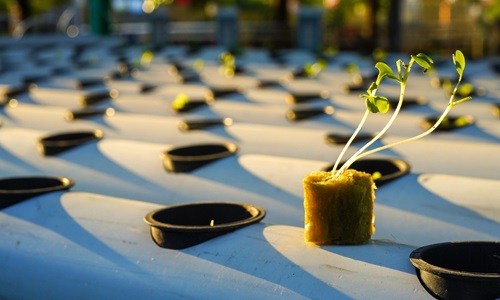Dec 12th 2024
Growing In Rockwool Cubes – How to Start Seeds in Rockwool
For centuries, planting crops meant putting seeds or seedlings in the ground. But with the advent of hydroponics, rockwool has become more and more popular as the perfect media for soil-less growing. Although there are many types of mediums which can be used for hydroponics, rockwool cubes have distinct advantages which make them popular.
What are rockwool cubes, then?
Rockwool, also referred to as mineral wool or stone wool, is a horticultural substrate composed of basalt or naturally occurring volcanic rock. After being molten and processed into fibers, it is shaped into a variety of forms, such as grow cubes. Rockwool cubes are made to give plants the best possible conditions for growth and development, especially in soil-less and hydroponic gardening systems.
Is Rockwool Safe for Plants?
Rockwool is valued by gardeners for its exceptional water retention, which guarantees plants receive steady hydration while permitting enough drainage, which is essential for root health. Additionally, because rockwool is inert, it resists mold, bugs, and illnesses, protecting plants from common gardening threats.
It is safe to use as a substrate and rooting media for plants. However, prolonged exposure to rockwool can pose some health risk to humans. Loose rockwool fibers may irritate skin, eyes, and lungs.
How Rockwool is Different to Other Growing Media

High temperatures are necessary for some growth medium, such as clay pebbles (sometimes called Hydroton), to take on their final shape. Although it is a step in the production of rockwool, it must also be shaped into fibrous strands. But there are additional distinctions between rockwool and other growth medium as well. In your backyard garden, you might use vermiculite or perlite, but it's quite doubtful that you'll utilize rockwool.
Before choosing rockwool cubes as your preferred growth medium, there are a few distinctions to be aware of. The most important fact about rockwool is that its pH is inherently high. This can raise the pH of the water flowing through your hydroponic system so you’ll want to have some pH down handy.
While many alternative growth mediums are in a more granular form, rockwool is also available in slab or cube shape. Rockwool's distinctive shape makes it an excellent material for clone roots and seed starting. You may transfer your plants into your hydroponic system soon after they have taken root.
Rockwool Cubes for Hydroponic Towers
For hydroponic towers, the preferred medium is often rockwool cubes . Gardeners may cultivate a lot of plants in a relatively small area thanks to hydroponic towers, which are mostly selected for their capacity to save space. The ALTO Garden GX Hydroponic Tower is our favorite hydroponic tower, and includes everything you need to build your own hydroponic garden.
Rockwool must be treated before being utilized in hydroponics, in contrast to the majority of other media. Before putting your plants in it, you should soak it in water that has been pH-treated. It requires a little more work than other hydroponics media, but it isn't a big deal to most people.
Planting Seeds and Cuttings in Rockwool

The largest phase in this process is essentially preparation. Now that you have prepared your rockwool cubes, you may begin germination of your seeds. Here's how to use rockwool as a medium for seed starting:
- After soaking and draining your cubes, poke a small hole in your cube and plant seeds in it.
- Lightly sprinkle some vermiculite into the planting holes and on top of the cubes. Moistening the vermiculite will help prevent your seeds from drying out.
- Add about 1/4” of water at the bottom of your tray and cover with a humidity dome.
- Depending on the temperature, a heated germination pad and/or a heat lamp may be used.
- Maintain moisture and temperature levels.
- As soon as your seeds sprout, move them under a germination light. Move them under light right away to avoid leggy seedlings. This will help kickstart the photosynthesis process.
Propagating Cuttings
Cuttings in rockwool cubes are propagated by simply inserting the stem cutting into the cube's top hole. For the cutting to successfully produce roots and avoid drying out, high humidity levels must be maintained during this process. Watch for any signs of illness or pests on your cuttings, and if needed, give proper treatment.
Transplanting and Integrating into Hydroponic Systems
It's time to move your cuttings or seedlings into your hydroponic growing system once they've grown to the proper size and established a strong root system. Depending on the particular system you're using, this procedure could change, but there are certain basic strategies to guarantee a seamless transfer. Here are a few things to consider when transferring.
- After seedlings have produced four leaves – you can transplant them into your system. This will help give your plants the highest chance of surviving the switch to the hydroponic system and be robust enough to withstand it.
- Other signs that your seedling is ready – is when the seedling is around 2 – 3 inches tall and has roots growing out from the bottom of the rockwool cube.
- There are a number of innovative ways to integrate rockwool cubes into hydroponic systems, including deep water culture, NFT channels, and floating rafts. Your own tastes and the kind of hydroponic system you're utilizing will determine the exact method you select.
Caring for Rockwool-Grown Plants
For plants and their roots to thrive, rockwool must remain continuously moist. It's critical to adjust your irrigation to achieve this. Because rockwool lacks nutrients, you should add a nutrient solution to your hydroponic reservoir. Watering and moisture control, nutrition management, and plant health monitoring are all important components of caring for plants grown in rockwool. You can guarantee your plants' continuous success in their rockwool habitat by closely monitoring these variables.




